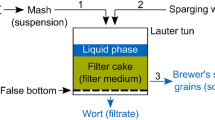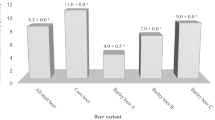Abstract
Malting changes the chemical and enzymatical composition of barley. During malting, enzymes are synthesized, cell walls (pentosans, proteins, etc.) degraded and starch becomes available for enzymatic attack. The progress of germination defines the final beer quality and processability in several aspects: mouthfeel, foam and haze formation (different proteins), processability (viscosity caused by certain substances, like β-glucan), fermentation progress (FAN, sugar content), etc. The objective of this research was to study the influence of different modified malt on turbidity in beer after filtration. This was achieved by analyzing selected malts at different germination stages and afterward studying their influence on the final beer composition, focusing on protein content and composition. Protein fractions were analyzed using a Lab-on-a-Chip technique, which separates the proteins—based on their molecular weight—by capillary electrophoresis. This analysis was supported by the use of two-dimensional gel electrophoresis (2D-PAGE). Additionally, common malt and beer analyses and turbidity and filterability measurements were performed. The protein composition could be followed from malt to beer with both the Lab-on-a-Chip technique and 2D-PAGE. No differences in protein composition could be seen in the final protein composition of the beer. However, it could be observed, with Lab-on-a-Chip technique, that high amounts of a protein fraction with a size of 25–28 kDa caused increased turbidity in the beer.


Similar content being viewed by others
Abbreviations
- EBC:
-
European Brewing Convention
- MEBAK:
-
Mitteleuropäische Brautechnische Analysenkommission
References
Curioni A et al (1995) Major proteins of beer and their precursors in barley: electrophoretic and immunological studies. J Agric Food Chem 43(10):2620–2626
Hejgaard J, Kaersgaard P (1983) Purification and properties of the major antigenic beer protein of barley origin. J Inst Brew 89 (6):402–410
Evans DE, Sheehan MC (2002) Don’t be fobbed off: the substance of beer foam. J Am Soc Brew Chem 60(2):47–57
Van Nierop SNE et al (2004) Impact of different wort boiling temperatures on the beer foam stabilizing properties of lipid transfer protein 1. J Agric Food Chem 52(10):3120–3129
Bamforth CW (1999) Beer haze. J Am Soc Brew Chem 57(3):81–90
Kaersgaard P, Hejgaard J (1979) Antigenic beer macromolecules: an experimental survey of purification methods. J Inst Brew 85(2):103–111
Nadzeyka A et al (1979) The significance of beer proteins in relationship to cold break and age-related haze formation. Brauwissenschaft 32(6):167–172
Siebert KJ et al (1996) Formation of protein-polyphenol haze in beverages. J Agric Food Chem 44(8):1997–2005
Asano K et al (1982) Characterization of haze-forming proteins of beer and their roles in chill haze formation. J Am Soc Brew Chem 40(4):147–154
Siebert KJ (1999) Protein-polyphenol haze in beverages. Food Technol (Chicago) 53(1):54–57
Siebert KJ (1999) Effects of protein-polyphenol interactions on beverage haze, stabilization, and analysis. J Agric Food Chem 47(2):353–362
Kreisz S (2002) Der Einfluss von Polysacchariden aus Malz. Hefe und Bakterien auf die Filtrierbarkeit von Würze und Bier, TU-München, Freising
Cach N, Annemüller G (1995) Ein Beitrag über die Pentosane im Prozess der Bierherstellung–sind sie wichtig oder technologisch unbedeutend? = Contribution on pentosans in the beer brewing process, are they important or insignificant technologically? Monatsschrift für Brauwissenschaft 48(7–8):232–241
Narziß L (2005) Abriss der Bierbrauerei, vol 7. Wiley, VCH
Shewry PR (1993) Barley seed proteins. Barley:131–197
Leiper KA et al (2003) Beer polypeptides and silica gel. Part II. Polypeptides involved in foam formation. J Inst Brew 109 (1):73–79
Leiper KA et al (2003) Beer polypeptides and silica gel. Part I. Polypeptides involved in haze formation. J Inst Brew 109(1):57–72
Leiper KA et al (2005) Optimising beer stabilisation by the selective removal of tannoids and sensitive proteins. J Inst Brew 111(2):118–127
MEBAK (2002) Brautechnische Analysenmethoden, vol 2nd Volume. 4th edn. Methodensammlung der Mitteleuropäischen Brautechnischen Analysenkommission
McMurrough I et al (1992) Effect of the removal of sensitive proteins and proanthocyanidins on the colloidal stability of lager beer. J Am Soc Brew Chem 50(2):67–76
Siebert KJ (2006) Haze formation in beverages. LWT–Food Sci Technol 39(9):987–994
Siebert KJ et al (1996) Nature of polyphenol-protein interactions. J Agric Food Chem 44(1):80–85
McManus JP et al (1985) Polyphenol interactions 1. Introduction; some observation on the reversible complexation of polyphenols with proteins and polysaccharides. J Chem Soc Perkin Trans 11:1429–1438
McMurrough I et al (1996) The role of flavanoid polyphenols in beer stability. J Am Soc Brew Chem 54(3):141–148
Okada Y et al (2008) The influence of barley malt protein modification on beer foam stability and their relationship to the barley dimeric alpha -amylase inhibitor-I (BDAI-I) as a possible foam-promoting protein. J Agric Food Chem 56(4):1458–1464
Nursten H (2005) The Maillard reaction: chemistry, biochemistry and implications. Royal Society of Chemistry, Cambridge
Esslinger HM (ed) (2009) Handbook of brewing: processes, technology, markets. Wiley, London
Kunze W (2007) Technologie Brauer und Mälzer, vol 9. VLB Berlin
Shewry PR et al (1978) Comparison of methods for extraction and separation of hordein fractions from 29 barley varieties. J Sci Food Agric 29(5):433–441
Shewry PR, Miflin BJ (1985) Seed storage proteins of economically important cereals. Adv Cereal Sci Technol 7:1–83
Jin B et al (2009) Proteomics study of silica eluent proteins in beer. J Am Soc Brew Chem 67(4):183–188
Jin B et al (2009) Structural changes of malt proteins during boiling. Molecules 14(3):1081–1097
Sheehan M, Skerritt J (1997) Identification and characterisation of beer polypeptides derived from barley hordeins. J Inst Brew 103(5):297–306
Jones BL (2005) Endoproteases of barley and malt. J Cereal Sci 42(2):139–156
Jones BL (2005) The endogenous endoprotease inhibitors of barley and malt and their roles in malting and brewing. J Cereal Sci 42(3):271–280
Jones BL, Budde AD (2005) How various malt endoproteinase classes affect wort soluble protein levels. J Cereal Sci 41(1):95–106
Zhang NY, Jones BL (1995) Characterization of germinated barley endoproteolytic enzymes by 2-dimensional gel-electrophoresis. J Cereal Sci 21(2):145–153
Poulle M, Jones BL (1988) A proteinase from germinating barley. I. Purification and some physical properties of a 30 kD cysteine endoproteinase from green malt. Plant Physiol 88(4):1454–1460
Finnie C et al (2004) Aspects of the barley seed proteome during development and germination. Biochem Soc Trans 32(3):517–519
Finnie C et al (2002) Proteome analysis of grain filling and seed maturation in barley. Plant Physiol 129(3):1308–1319
Finnie C et al (2003) Barley proteome analysis, starch degrading enzymes and proteinaceous inhibitors. J Appl Glycosci 50(2):277–282
Finnie C, Svensson B (2009) Barley seed proteomics from spots to structures. J Proteomics 72 (3):315–324
Jones BL (1997) Malt endoproteinases; their synthesis and inactivation during malting and mashing. Proc 1st Eur Symp Enzym Grain Process, pp 54–64
Jones BL, Budde AD (1999) Endoproteinases and the hydrolysis of malt proteins during mashing. Proc Congr—Eur Brew Conv 27th:611–618
Asano K, Hashimoto N (1980) Isolation and characterization of foaming proteins of beer. J Am Soc Brew Chem 38(4):129–137
Iimure T et al (2009) Identification of novel haze-active beer proteins by proteome analysis. J Cereal Sci 49(1):141–147
Bamforth CW (2001) A brewer's biochemistry. Brew int 1(3):21–25
Djurtoft R (1965) Composition of the protein and polypeptide fraction of EBC beer haze preparations. J Inst Brew 71(4):305–315
Mussche R (1990) Physico-chemical stabilization of beer using new generation gallotannins. Proc 21st Conv—Inst Brew (Aust NZ Sect), pp 136–140
Osman AM (2003) Barley and malt proteins and proteinases: II. The purification and characterisation of five malt endoproteases, using the highly degradable barley protein fraction (HDBPF) substrate. J Inst Brew 109(2):142–149
Osman AM (2003) Barley and malt proteins and proteinases: I. Highly degradable barley protein fraction (HDBPF), a suitable substrate for malt endoprotease assay. J Inst Brew 109(2):135–414
Osman AM (2003) Barley and malt proteins and proteinases: III. A simple method for estimating the combined actions of malt proteinases and the extent of prtein degradation during malting. J Inst Brew 109(2):150–153
Author information
Authors and Affiliations
Corresponding author
Rights and permissions
About this article
Cite this article
Steiner, E., Arendt, E.K., Gastl, M. et al. Influence of the malting parameters on the haze formation of beer after filtration. Eur Food Res Technol 233, 587–597 (2011). https://doi.org/10.1007/s00217-011-1547-0
Received:
Revised:
Accepted:
Published:
Issue Date:
DOI: https://doi.org/10.1007/s00217-011-1547-0




